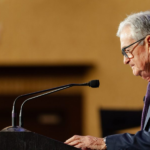A Reuters poll indicates that the U.S. Federal Reserve is expected to keep interest rates unchanged until at least July, a shift from previous expectations. The majority of economists surveyed, 97 out of 102, believe that the Fed’s next move will be to adjust the real rate of interest rather than initiating a stimulus. Despite Chair Jerome Powell’s recent remarks about potential policy tightening, most economists in the poll predict that the Fed has concluded its hiking cycle.
The debate now centers on the duration of the federal funds rate within the 5.25%-5.50% range and the number of rate cuts in the upcoming year, with expectations appearing to be lower than current market projections. While markets anticipate around 150 basis points of cuts starting in March, the survey suggests a more conservative outlook, with 52 out of 102 economists predicting no rate cuts until at least July. Additionally, 72 respondents forecast 100 basis points of cuts or less in the coming year.

The discrepancy between market expectations and economist predictions reflects uncertainty about the timing of rate cuts, with some experts cautioning that markets may be underestimating the persistence of high inflation. Andrew Hollenhorst, Chief U.S. Economist at Citi, suggests that inflation pressures may delay rate cuts until economic activity shows clearer signs of slowing, possibly occurring in the third quarter of next year.
The Reuters poll also reveals that all inflation measures, including the consumer price index (CPI), core CPI, personal consumption expenditures (PCE), and core PCE, are expected to gradually decline but remain above the central bank’s 2% PCE target until at least 2025. However, concerns about the real rate becoming more restrictive if left unchanged, posing a risk to the economy, prompt experts to suggest that adjusting the real rate down may trigger the first rate cut.
The U.S. economy, having grown at a robust pace in the last quarter, is expected to experience a slight slowdown, with a projected expansion of 1.2% in the current quarter and an average of 1.2% in 2024. Despite facing the most aggressive tightening cycle in four decades, the economy has demonstrated resilience, maintaining low unemployment rates and high price pressures.
Some economists, including Ellen Zentner, Chief U.S. Economist at Morgan Stanley, emphasize the importance of distinguishing between cutting rates and easing, suggesting that the Fed’s actions in 2024 aim to maintain a certain level of restrictiveness rather than initiating an easing cycle.









